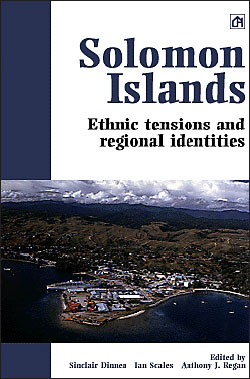Solomon Islands Ethnic Tensions and Regional Identities
Solomon Islands charts the key developments in a little-known conflict on Australia’s
doorstep, documenting events from the emergence of ethnic tensions on Guadalcanal in late 1998 to
the current post-Townsville peace process. Contributors include a range of participants in, and
observers of, the conflict and peace processes in Solomon Islands.
Guadalcanal, home of Honiara, the national capital, has been a favourite destination for the
country’s internal migrants, particularly from the densely populated island of Malaita. Ethnic tensions
between locals and Malaitan settlers have been building over many years. Guadalcanal people have
been concerned about the impact of migration on local cultures. There has also been deliberate
manipulation of perceived ethnic differences by political interests threatened by the election of the
reformist Ulufa‘alu government in 1997. These tensions escalated dramatically in 1998.
Militant Guadalcanal groups - now called the Isatabu Freedom Movement (IFM) - embarked on
a violent campaign of intimidation against settlers from Malaita. In response the the deaths of at least
fifteen people, and the flight of more than 20 000 Malaitans from their homes in rural Guadalcanal, the
Malaita Eagle Force (MEF), a militant group claiming to represent the interests of displaced Malaitans
on the island, was formed. Militant activists forced the closure of major national investment projects
on Guadalcanal.
On 5 June 2000, MEF militants, together with disaffected police officers, seized control of key
installations in Honiara, including the national armoury. Prime Minister Ulufa‘alu was forced to resign
and replaced by Manasseh Sogavare, who was believed to be more sympathetic to the MEF. The
legitimacy of the new government thus remains contentious.
Australia and New Zealand have been actively facilitating peace negotiations between the militant
factions and the Solomon Islands government, and continue to monitor the process. A ceasefire
agreement on 3 August 2000 was followed by the Townsville Peace Agreement on 15 October.
Events in and around Honiara precipitated latent tension between national and regional identities
throughout the country. Services declined, and militants in Honiara attacked people from a number
of provinces other than Guadalcanal. Fear spread across the nation. Western and Choiseul provinces
combined and declared themselves ‘the State of Western Solomons’. Temotu and Rennell-Bellona
provinces declared their intention to push for complete independence. These schisms have deeper
historical origins than the events of 1998 to 2000, and have led to calls for constitutional reform to
allow a greater degree of regional autonomy.
While the Ulufa‘alu government improved Solomon Islands’ economic prospects, the nation verges
on bankruptcy. It is not clear how the paramilitary police, deeply compromised through collusion with
militants in Honiara, can reassume their role as a legitimate arm of the government. In addition,
hundreds of automatic weapons remain at large. The ethnic tensions have by no means been resolved,
and could easily re-erupt if the quality of governance and economic conditions continue to deteriorate.
The Solomon Islands situation has broader regional significance in that it is part of an ‘arc of
instability’ along Australia’s northern edge, and which is related to wider forces of globalism. These
forces involve the enormous pressures globalism places on nation-states while often stimulating the
emergence of micronationalist movements under banners of historico-regional ‘ethnic’ identities.
This is something that other countries in the region (such as Australia and New Zealand) must
understand in necessarily reformulating their foreign policies.
|
|

AUTHOR:
(edited by) Sinclair Dinnen, Ian Scales & Anthony Regan
STATUS:
Forthcoming
PRICE:
$39.95
ILLUSTRATIONS:
6 black-and-white photographs,2 maps
FORMAT:
Portrait; softcover; c. 350 pages
DIMENSIONS:
204 x 135 mm
ISBN:
1863332197
|
|

